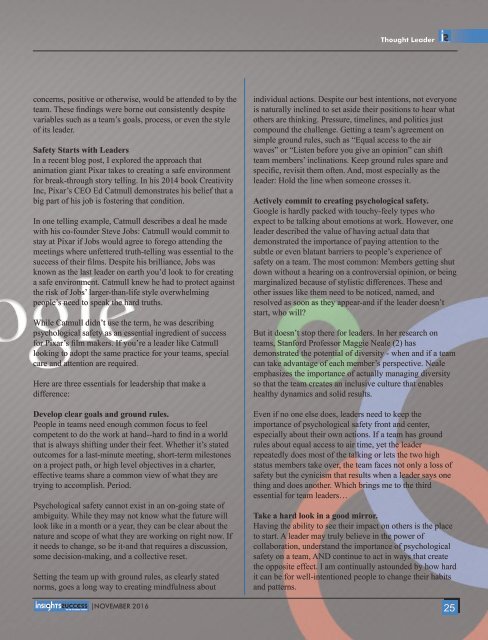Insights Success The 10 Fastest Growing Utilities and Energy Solutions Provider Companies
Insights Success The 10 Fastest Growing Utilities and Energy Solutions Provider Companies
Insights Success The 10 Fastest Growing Utilities and Energy Solutions Provider Companies
Create successful ePaper yourself
Turn your PDF publications into a flip-book with our unique Google optimized e-Paper software.
Thought Leader<br />
concerns, positive or otherwise, would be attended to by the<br />
team. <strong>The</strong>se findings were borne out consistently despite<br />
variables such as a team’s goals, process, or even the style<br />
of its leader.<br />
Safety Starts with Leaders<br />
In a recent blog post, I explored the approach that<br />
animation giant Pixar takes to creating a safe environment<br />
for break-through story telling. In his 2014 book Creativity<br />
Inc, Pixar’s CEO Ed Catmull demonstrates his belief that a<br />
big part of his job is fostering that condition.<br />
In one telling example, Catmull describes a deal he made<br />
with his co-founder Steve Jobs: Catmull would commit to<br />
stay at Pixar if Jobs would agree to forego attending the<br />
meetings where unfettered truth-telling was essential to the<br />
success of their films. Despite his brilliance, Jobs was<br />
known as the last leader on earth you’d look to for creating<br />
a safe environment. Catmull knew he had to protect against<br />
the risk of Jobs’ larger-than-life style overwhelming<br />
people’s need to speak the hard truths.<br />
While Catmull didn’t use the term, he was describing<br />
psychological safety as an essential ingredient of success<br />
for Pixar’s film makers. If you’re a leader like Catmull<br />
looking to adopt the same practice for your teams, special<br />
care <strong>and</strong> attention are required.<br />
Here are three essentials for leadership that make a<br />
difference:<br />
Develop clear goals <strong>and</strong> ground rules.<br />
People in teams need enough common focus to feel<br />
competent to do the work at h<strong>and</strong>--hard to find in a world<br />
that is always shifting under their feet. Whether it’s stated<br />
outcomes for a last-minute meeting, short-term milestones<br />
on a project path, or high level objectives in a charter,<br />
effective teams share a common view of what they are<br />
trying to accomplish. Period.<br />
Psychological safety cannot exist in an on-going state of<br />
ambiguity. While they may not know what the future will<br />
look like in a month or a year, they can be clear about the<br />
nature <strong>and</strong> scope of what they are working on right now. If<br />
it needs to change, so be it-<strong>and</strong> that requires a discussion,<br />
some decision-making, <strong>and</strong> a collective reset.<br />
Setting the team up with ground rules, as clearly stated<br />
norms, goes a long way to creating mindfulness about<br />
individual actions. Despite our best intentions, not everyone<br />
is naturally inclined to set aside their positions to hear what<br />
others are thinking. Pressure, timelines, <strong>and</strong> politics just<br />
compound the challenge. Getting a team’s agreement on<br />
simple ground rules, such as “Equal access to the air<br />
waves” or “Listen before you give an opinion” can shift<br />
team members’ inclinations. Keep ground rules spare <strong>and</strong><br />
specific, revisit them often. And, most especially as the<br />
leader: Hold the line when someone crosses it.<br />
Actively commit to creating psychological safety.<br />
Google is hardly packed with touchy-feely types who<br />
expect to be talking about emotions at work. However, one<br />
leader described the value of having actual data that<br />
demonstrated the importance of paying attention to the<br />
subtle or even blatant barriers to people’s experience of<br />
safety on a team. <strong>The</strong> most common: Members getting shut<br />
down without a hearing on a controversial opinion, or being<br />
marginalized because of stylistic differences. <strong>The</strong>se <strong>and</strong><br />
other issues like them need to be noticed, named, <strong>and</strong><br />
resolved as soon as they appear-<strong>and</strong> if the leader doesn’t<br />
start, who will?<br />
But it doesn’t stop there for leaders. In her research on<br />
teams, Stanford Professor Maggie Neale (2) has<br />
demonstrated the potential of diversity - when <strong>and</strong> if a team<br />
can take advantage of each member’s perspective. Neale<br />
emphasizes the importance of actually managing diversity<br />
so that the team creates an inclusive culture that enables<br />
healthy dynamics <strong>and</strong> solid results.<br />
Even if no one else does, leaders need to keep the<br />
importance of psychological safety front <strong>and</strong> center,<br />
especially about their own actions. If a team has ground<br />
rules about equal access to air time, yet the leader<br />
repeatedly does most of the talking or lets the two high<br />
status members take over, the team faces not only a loss of<br />
safety but the cynicism that results when a leader says one<br />
thing <strong>and</strong> does another. Which brings me to the third<br />
essential for team leaders…<br />
Take a hard look in a good mirror.<br />
Having the ability to see their impact on others is the place<br />
to start. A leader may truly believe in the power of<br />
collaboration, underst<strong>and</strong> the importance of psychological<br />
safety on a team, AND continue to act in ways that create<br />
the opposite effect. I am continually astounded by how hard<br />
it can be for well-intentioned people to change their habits<br />
<strong>and</strong> patterns.<br />
|NOVEMBER 2016<br />
25


















